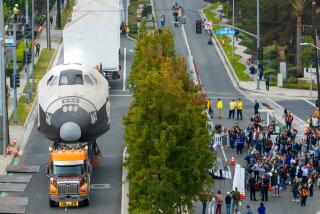Satellite Gathers Data After Gathering Dust
- Share via
SANTA BARBARA — A satellite that sat in museum display for more than eight years was put to work Thursday when it was launched atop a Scout rocket from Vandenberg Air Force Base.
The unlikely scenario of a museum relic being called into service began two years ago when the Air Force attempted to obtain one of the Navy’s navigation satellites.
The Navy could not spare any satellites, so the Air Force contacted David Grant, a program manager at the Applied Physics Laboratory at Johns Hopkins University in Baltimore, which had built the units about 15 years ago. Grant attempted to track down a surplus model but was unsuccessful.
Then he recalled a recent family outing to the Smithsonian Institution’s Air and Space Museum in Washington, and he remembered seeing one of the satellites.
He called the curator of the museum, traded another vintage satellite that had been on display at a Johns Hopkins visitors center, and the Air Force was able to proceed with its program. And Thursday, the satellite that had once gathered dust in a display was launched into orbit.
“I live near the museum and visit pretty often with my kids,” Grant said. “So I thought about the Smithsonian when the Air Force said it was looking for a satellite.”
By revamping the old satellite, rather than building a new one, the Air Force saved $2 million to $3 million and was ready for launch six months earlier, Grant said.
The 275-pound satellite, which will orbit 625 miles around the Earth’s poles, will photograph the aurora borealis, or northern lights, electrical discharges illuminating the night sky in the Arctic regions, an Air Force spokesman said. The satellite will also be used to improve communications over the poles, where there is natural interference from solar flares and other factors. Scientists hope to learn more about how to predict the occurrence of such interference and how to bypass it by using other frequencies.
Although the former Navy satellite, renamed Polar Bear, for Polar Beacon Experiments and Auroral Research, was originally designed for navigation, the Air Force determined that it could be modified for their purposes. The satellite’s framework and solar panels were kept intact, but the Air Force installed electronic changes and additions to the structure.
The launch of a former museum piece is a first for the Air Force. But the Air and Space Museum has loaned several items back to NASA that were used in launches, said Allan Needell, curator of the museum’s space science and exploration department.
“We display real artifacts; we don’t use models,” Needell said. “So we make sure they’re taken care of. They’re entrusted to us, so we’d like them to last in the museum so our grandchildren can see them. And if, as a byproduct, they’re still usable, that’s great too.”
In addition to the money saved by reusing the satellite, the Air Force saved $6 million by using spare parts to build the 75-foot-tall Scout rocket, making its 107th flight in 26 years. Overall, the project cost about $12 million.
The launch, originally scheduled for October, had been delayed twice because of problems with ground equipment and the rocket’s guidance system. But it lifted off at 4:22 p.m. Thursday from Space Launch Complex-5 at the Vandenberg base in northern Santa Barbara County, said Air Force spokeswoman Lt. Sharon Walker.
“It looks beautiful,” she said.
More to Read
Sign up for Essential California
The most important California stories and recommendations in your inbox every morning.
You may occasionally receive promotional content from the Los Angeles Times.













